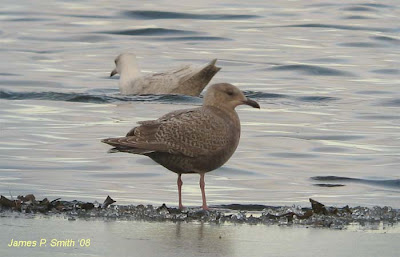Noted quite a few Peach-faced Lovebirds this morning whilst carrying out urban point counts at sites around Phoenix. Had a total of seven off McKellips Road in Mesa and over a dozen in Papago Park, Phoenix.
Another 'exotic' of interest in Papago Park was a probable Ringed Turtle-Dove. I'd been seeing Eurasian Collared Doves throughout the morning but this bird was striking, being rather paler with most of the belly, vent, undertail coverts and undertail appearing completely pale, creamy white. Eurasian Collared Dove, though very variable, is usually darker showing at least some visible black towards the base of the tail when perched. This bird also appeared smaller and more petite than Eurasian Collared. Recent parusals of the web would suggest a general push towards dropping the name 'Ringed Turtle-Dove', and picking up the name African Collared Dove which would be a tad disappointing as these birds just don't look quite as neat as pure African Collared. However, Ringed Turtle-Doves are apparently direct descendants of escaped African Collared Doves and share the same scientific name. Hybrids between Eurasian Collared Dove and Ringed Turtle-Dove have been reported. Anyhow, a bird of interest for me at least having spent many head-breaking hours looking for African Collared Doves in Southern Israel.
I was also impressed by the number of Bronzed Cowbirds present in Papago Park, I think quite uncommon in Maricopa County in mid-winter.
All of these are 'digibin' images.


Peach-faced Lovebirds - a reasonably well established exotic in parts of the Phoenix area.


possible Ringed Turtle Dove - more or less continually white from the lower belly to the tail tip.

Bronzed Cowbird - about 12 males in Papago Park.
Good birding,
JPS.
 Greater White-fronted Geese - adult and first-winter, McCormick Ranch. The adult is almost certainly the same that I found close to this location on Dec 22nd, 2007. The younger bird wasn't present on that date.
Greater White-fronted Geese - adult and first-winter, McCormick Ranch. The adult is almost certainly the same that I found close to this location on Dec 22nd, 2007. The younger bird wasn't present on that date.

 Adult Ross's Goose - managed to get rid of the fishing line shortly after this image was taken!
Adult Ross's Goose - managed to get rid of the fishing line shortly after this image was taken!
















































